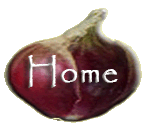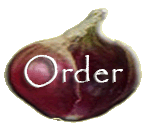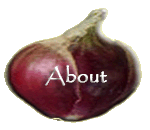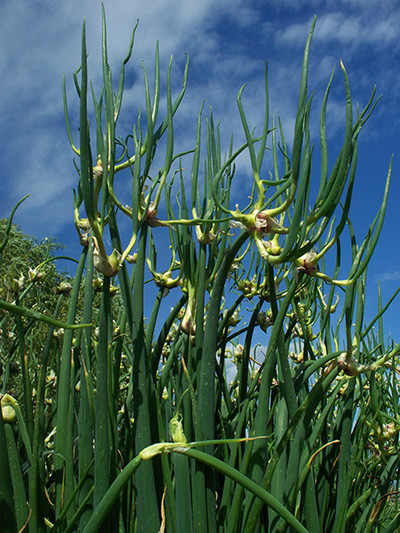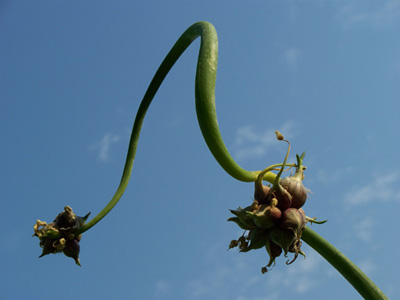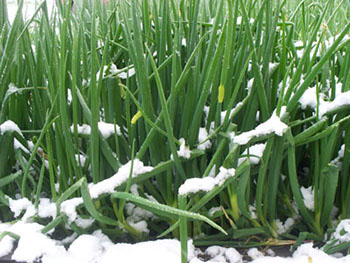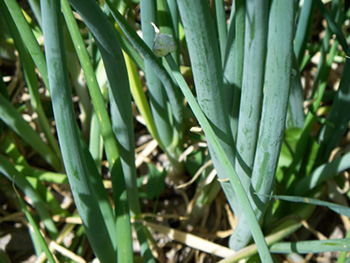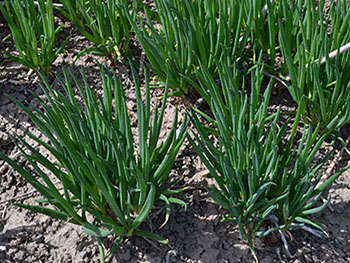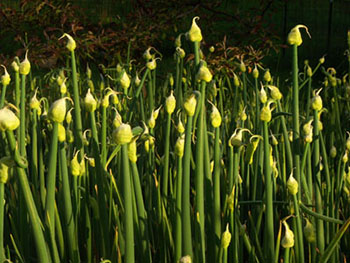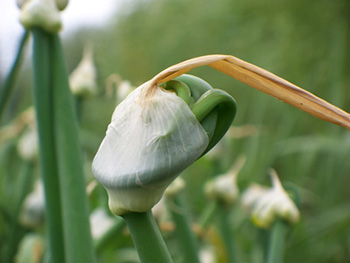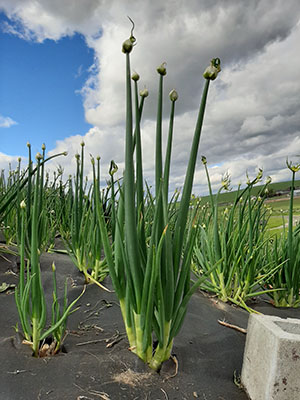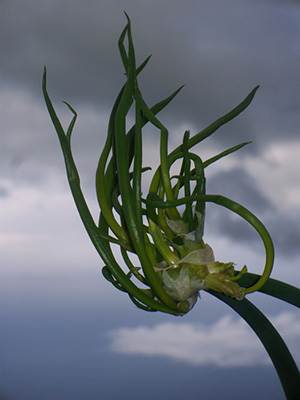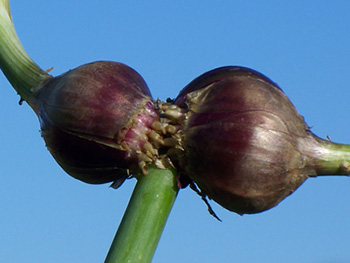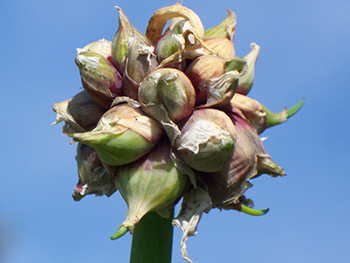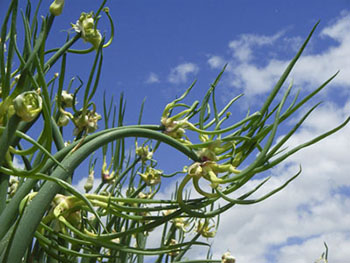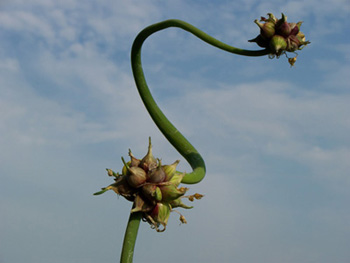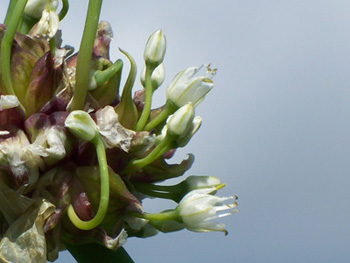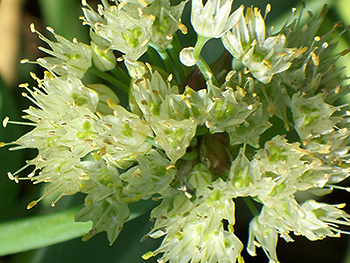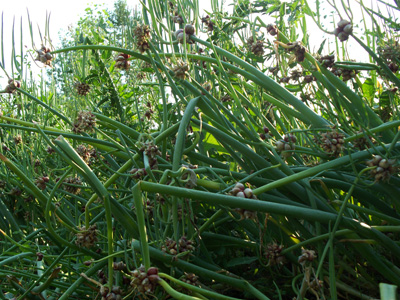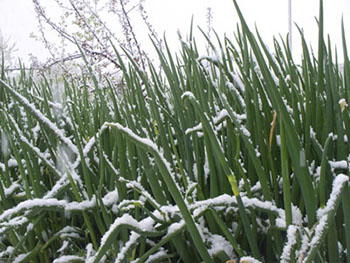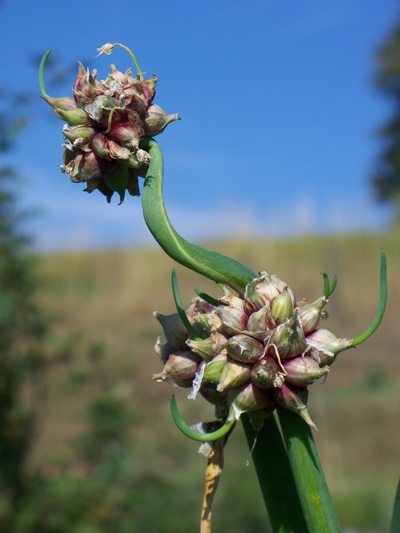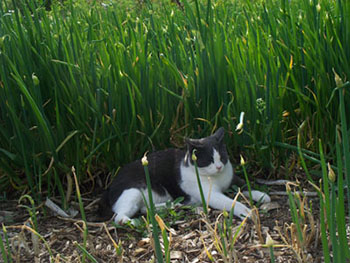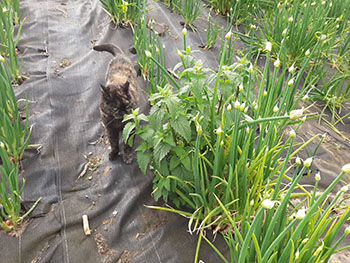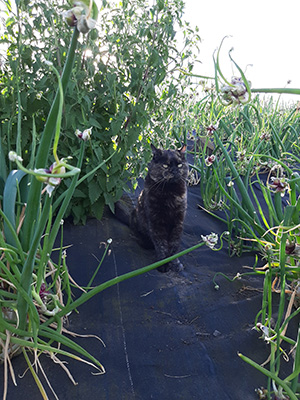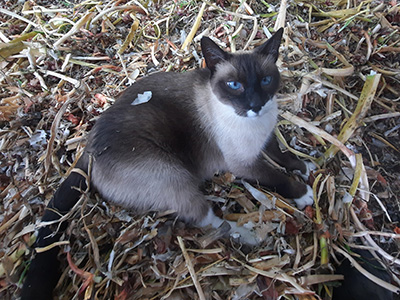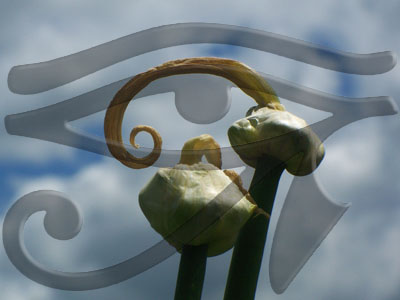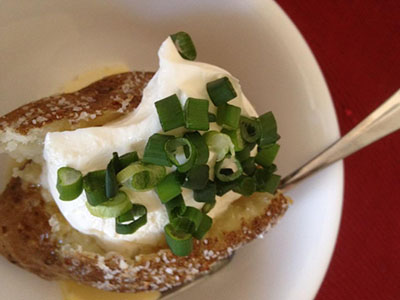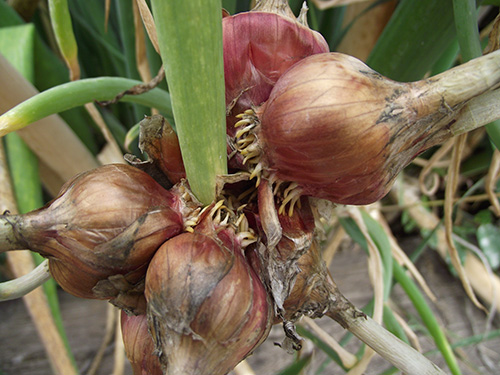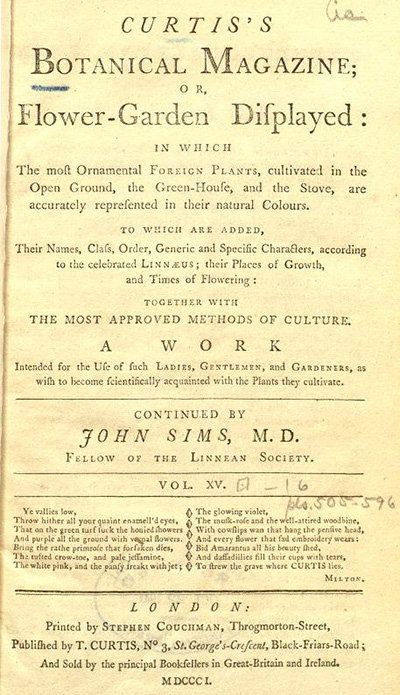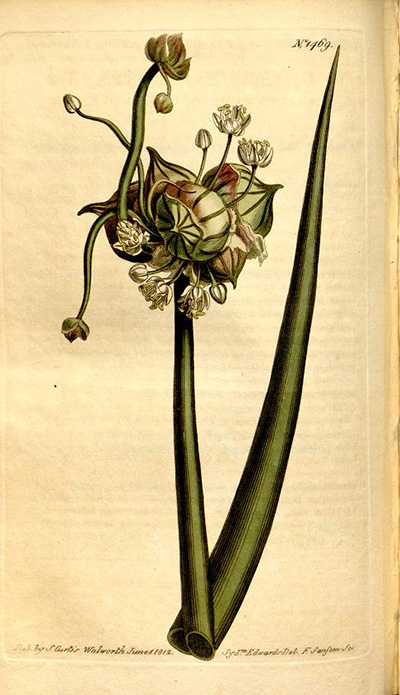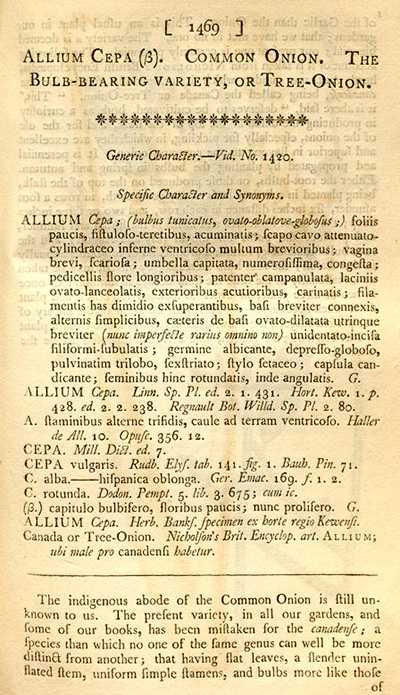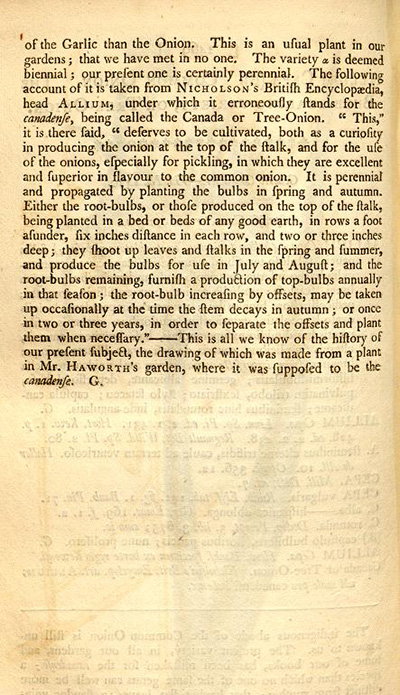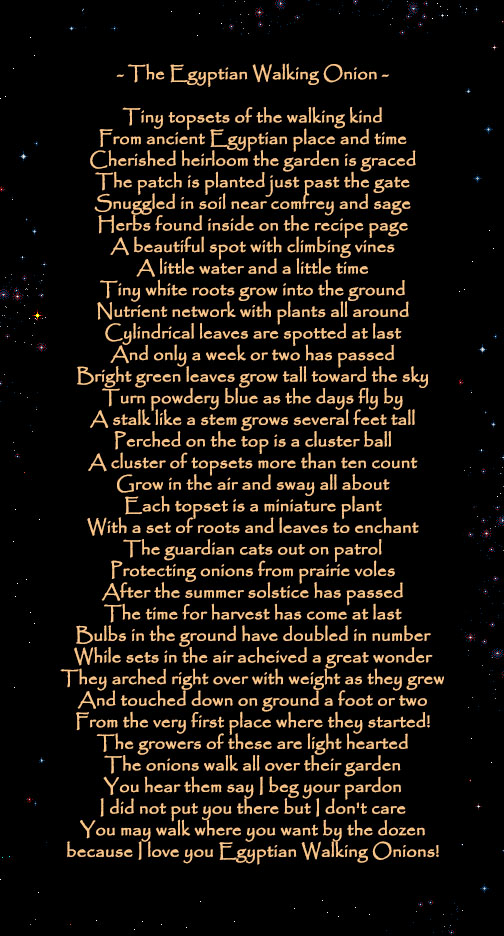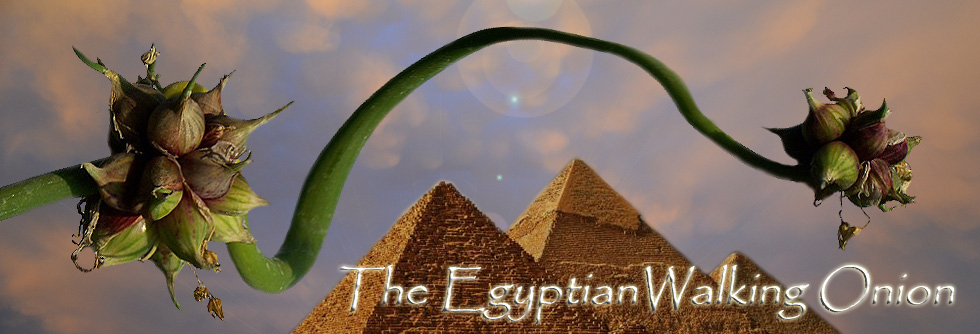
|
- Official Website - ...the
best place to purchase real heirloom Egyptian Walking Onions online! Remember
those mysterious onions your parents or grandparents used to have? We grow organic red and white Egyptian Walking Onions. The incredible, edible, everlasting, cold hardy, ornamental.....ONION!
|
|||||||||||||||||||||||||||||||||||||||||||||||||||
|
All about the ONION that WALKS! Is there really an onion plant that walks? The honest answer....YES! Absolutely! Well now how can an onion plant walk? Here's the story in a nutshell: The Egyptian Walking Onion plant starts out growing just like any other onion plant in the early spring. It could be mistaken for an ordinary onion until around May. That's when the magic happens. In May the Egyptian Walking Onion plant grows something marvelous at the top of its stalk. While all the other onion plants are busy growing a nice round puff ball of flowers, the Egyptian Walking Onion is growing miniature versions of itself! That's right! It's growing a cluster ball of cute little onion sets on the top of its stalk! As the summer months roll on, these cluster balls of topsets continue to grow to their full size, and can get pretty heavy for a tall onion stalk. Eventually, the stalk gets pulled over from the weight of the topsets, and they hit the ground, which may be up to 3 feet from the parent plant. If left to their own devices, the topsets will take root and grow new Egyptian Walking Onion plants right where they landed. The new plants will in turn grow their own topsets, which will eventually pull over, hit the ground, and take root. In this fashion, the Egyptian Walking Onion walks around the garden! Where they are headed is anybody's guess. “It
is a serious thing just to be alive on this fresh morning in this
broken world.” As their scientific name "Allium proliferum" states, these hardy little onions are very "prolific." After planting them in your garden you will have onions every year for the rest of your life! Egyptian Walking Onions are also called "Tree Onions, Egyptian Tree Onions, Top Onions, Topset Onions, Winter Onions, or Perennial Onions." I like the name "Egyptian Walking Onion" the best. It was that name which drew me to this plant in the first place. I mean, an onion that walks? I had to have it! Read on to learn more about these fascinating onions...
|
|||||||||||||||||||||||||||||||||||||||||||||||||||
|
Life Cycle of the Egyptian Walking Onion: Leaf Stage: Egyptian Walking Onions are one of the first plants to emerge from the garden in late winter/early spring. The leaves poke up through the soil like little green spikes and shoot towards the sky despite the frost or snow. The blue-green leaves are round and hollow, and tasty! They are the solar panels that photosynthesize to create sugar to feed the plant and grow onion bulbs at both ends. Yes, both ends! These plants grow onions in the ground and in the air! “Keep
some room in your heart for the Unimaginable.” You can clip some leaves at this stage and use them like scallions or chives. As the spring progresses, the leaves will make way for the dominant stalk that will grow up to 3 feet high! At the the top of the stalk, a cluster of bulblets will begin to grow. These bulblets are also known as "bulbils" or "sets." We will refer to them as "topsets" throughout this website because they literally are onion sets growing at the top of the plant. Every Egyptian Walking Onion plant will produce a cluster of sets at the top, hence the name, "Top Onion," or "Topset Onion" meaning they are top-setting onions.
|
|||||||||||||||||||||||||||||||||||||||||||||||||||
|
|
|
||||||||||||||||||||||||||||||||||||||||||||||||||
|
|||||||||||||||||||||||||||||||||||||||||||||||||||
|
Dividing Stage: In the ground, the Egyptian Walking Onion plant produces a small shallot-like onion which can be harvested. Once harvested, however, the plant will obviously not grow back. If left in the ground, the onion will divide and form a cluster or clump of onion bulbs. New leaves, stalks, and topsets will grow from the clump of onions each year. The bulbs in the photo on the right grew from one mature Egyptian Walking Onion bulb in one growing season - 1 plant became 6 plants! There can be as many as 50 bulbs or more in one clump after several years. It is a good idea to divide the clumps and thin them out because the topsets that grow from crowded clumps tend to be much smaller (1/4" and under). Crowded clumps also tend to produce more flowers and less topsets. The plants themselves are smaller and so are the bulbs in the ground.
|
|||||||||||||||||||||||||||||||||||||||||||||||||||
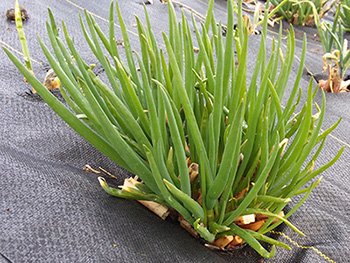 A crowded clump of Egyptian Walking Onions. |
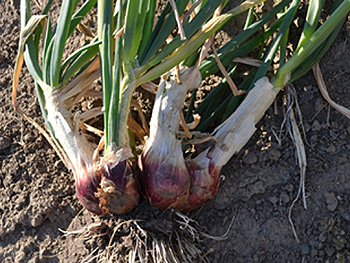 Egyptian Walking Onion bulbs |
||||||||||||||||||||||||||||||||||||||||||||||||||
|
Egyptian Walking Onions are perennial plants and will grow back each year and yield new and bigger clusters of sets on the top and new onion bulbs in the soil - they will divide and form clumps. Once established, plants may be propagated by division or by planting the topsets. Egyptian Walking Onions are extremely hardy plants. Our plants have endured harsh winters with temperatures plummeting down to -24° below zero! Hence the name, "Winter Onion." They grow well in zones 3-9.
There is a lot of variation in Egyptian Walking Onion plants. Some plants form long, twisting branches and very few topsets, while others produce large clusters of topsets and no branches. Some plants grow only 2 topsets and others will grow 30! Some plants my produce lots of flowers and very few topsets. Every plant is unique and beautiful. They can be grown for both food and ornamental purposes. All parts of the Egyptian Walking onion plant are edible. Yum!
Egyptian
Walking Onion Guardians:
How and when to plant your Egyptian Walking Onion topsets: Plant
each individual "topset" in the soil about 2 inches
deep. Soil should be slightly moist and well drained. Onions hate
wet feet.... or do they? I threw a bunch of topsets on the ground
one autumn and the winter that followed was very wet with flooding
conditions. The topsets were under 2 inches of water. In February
they began to sprout and grow despite their wet feet. Planting in the spring: This is a good time to plant your Egyptian Walking onion topsets. The topsets will grow throughout the spring and summer and develop tall green leaves and bulb/root growth in the ground. Since it is the plant's first growing season, it will probably not produce topsets, unless it is a huge (jumbo) topset. Planting in the summer: Topsets planted at this time will grow roots and leaves, and have some onion bulb development in the ground, but they will not produce topsets. Planting
in the fall:
This
is the optimum time to plant your Egyptian Walking Onion
topsets. Topsets planted at this time will grow roots and leaves
only. The leaves will die back when winter sets in. The topset
will develop into a small onion bulb in the ground and store enough
energy to carry itself through the winter. A leaf will reemerge
in late winter/early spring, and the plant will grow throughout
the spring and summer to maturity. More than likely, there will
be no topset growth the first summer, but some plants have produced
topsets their first summer after planting in the fall. Did
you know that Allium bulbs, such as the Egyptian Walking Onion,
Bulbs
to plant in the fall include: Alliums, Tulips, Daffodils, Hyacinth,
Crocus, Planting in the winter: Yes! You can plant Egyptian Walking Onion topsets in the winter as long as the soil is not frozen. If you can dig a 2" deep hole in the soil, then you can plant your sets. The topsets will not grow much at all - maybe a little bit of root growth only, unless you live where the winters are mild. If this is the case, you might also get a leaf. When planting in the winter, mulching is a good idea. In fact, mulching is good practice at any time of the year. Mulching keeps the weeds down, prevents unnecessary water evaporation and erosion, and fertilizes your plants. Planting by Nature: Unharvested topsets that are left to lie on the ground will self-sew. No planting necessary, they will grown on their own. Of course this will only happen if the conditions for growth are right. Optimum conditions include bare soil (no grass) and plenty of moisture. Planting mature bulbs: Plant mature bulbs so that the roots are down into the soil. The bulb itself should be planted to a depth of at least half way up the bulb. The bottom half of the bulb should be burried in the ground.
How to Harvest Your Egyptian Walking Onions: Harvesting the topsets: In mid to late summer, and autumn, the topsets may be harvested. The optimal time to pluck off the topsets is when the stalk has dried and turned brown. More than likely, it has fallen over by this time. Be sure to remove any topsets that have fallen to the ground if you do not want them to self-sow in their new locations. Despite their name, these plants are very easy to control and keep from spreading just by harvesting the topsets. You can eat, plant, share, or store your Egyptian Walking Onion topsets. If you want to store them, they need to stay in dark, cold, and dry conditions (more about this later). Harvesting the greens: The greens (leaves) may be cut and harvested at any time of the year. Just harvest one or two leaves from each plant. Be careful not to cut the stalk that has the topsets. Soon after you have harvested the leaves from an Egyptian Walking Onion plant, new leaves will start to grow in their place which can be harvested again. If you live in a mild climate, your Egyptian Walking Onion plant may produce greens all year round. In the fall after the topsets have matured and fallen to the ground, or after they have been harvested, new greens will start to grow - yummy! Harvesting the onion bulbs in the ground: The onions at the base of the plant that are growing in the ground can be harvested in late summer and fall. Be sure to leave some onions in the ground for next year's crop. An Egyptian Walking Onion bulb is about the same size and shape as a shallot. Bigger bulbs may be obtained by cutting off the topsets before they develop. That way the plant can put its energy into the onion bulb in the ground instead of into the topsets. To get bigger bulbs, keep the clumps thinned out to 2-8 plants per clump. If you do not divide and replant (or harvest) your clumps in the fall, the clumps will get bigger and bigger with many bulbs and they will be small. Note: if you harvest the onion bulb in the ground, you will destroy the plant - it will not grow back next year. So, if you want to eat the onion bulbs in the ground, make sure to replace them by planting topsets, or offsets from the bulb (divisions).
How to eat your Egyptian Walking Onions: Egyptian Walking Onions taste just like a regular onion, only with a bit more pizzazz! The entire plant can be eaten. Shallot-like onions form at the base in the soil. They can be eaten and prepared just like any other onion or shallot. The hollow greens may be chopped to eat like chives or green onions (scallions). They are excellent when fried, cooked in soups, or raw in salads (my favorite). The topsets are excellent when peeled and fried. You can even pickle them like pearl onions. Or just pop them in your mouth like popcorn! Watch out, they're a little spicy!
Here's a recipe for pickling the topsets: Ingredients: In a medium saucepan of boiling salted water, cook the topsets until just tender, about 8 minutes. Drain, rinse under cold water and drain again. Transfer the onions to a glass bowl. Meanwhile, in another medium saucepan, bring the water and vinegar to a boil with the sugar, mustard seeds, coriander seeds and peppercorns. Boil until the sugar is dissolved, about 2 minutes. Pour the liquid over the onions and refrigerate for at least 1 hour and up to 2 days. Drain before serving. The drained pickled onions can be refrigerated for up to 2 weeks.
Names of the Egyptian Walking Onion: Common names: "Egyptian Walking Onion" or "Walking Onion": The name "Egyptian" is very mysterious. The ancient Egyptians worshipped onions. They believed that its spherical shape and concentric rings symbolized eternal life. Onions were even used in Egyptian burials for the pharaohs. Small onions were found in the eye sockets of Ramesses IV! *shudder* It is not known whether the Egyptian Walking Onion came from the Egyptians or not. The "Egyptian" part of the name remains a mystery. Maybe the name refers to the way they walk.....do they "walk like an Egyptian?" There
is another explanation from a website in the UK (treeonions.com):
"Many of the old seed and plant catalogues can refer to tree
onions as "Egyptian onions", presumably for the notion
that these onions originated in Egypt but more likely a corruption
of "gypsy" and the introduction of these plants to some
areas by travellers." The name "Walking Onion" was given to this plant because it literally walks to new locations. When the cluster of topsets becomes heavy enough, it will pull the plant over to the ground. Depending on how tall the plant is and where the bend occurs, the topsets may fall up to 3 feet away from the base of the plant. Wherever the topsets land on the ground, if the conditions are right, they will take root and grow new plants. When these new plants mature, their topsets will eventually fall to the ground and start the process all over again. Egyptian Walking Onion plants can walk between 1 and 3 feet per year (and farther if the topset cluster gets to roll down a hill after getting batted around by a cat guardian!) "Tree Onion": Egyptian Walking Onions are known for their ability to grow a twisting stalk from the cluster of sets at the top of the plant. Another cluster of sets will grow at the end of this second stalk giving the plant a branching, tree-like appearance. Sometimes a third branch will grow, and there will be a third cluster of topsets! And yes, I've seen a 4th branch! "Top Onion", "Topset Onion", or "Top Setting Onion": Egyptian Walking Onions grow a cluster of sets (mini onions) at the top of the plant instead of seeds. "Winter Onion": These Onions can survive freezing cold winters with temperatures plummeting well below 24°F! They are hardy to zone 3. Taxonomic names: The following three scientific names refer to the Egyptian Walking Onion plant: Allium
cepa var. proliferum Here is an interesting article from an 1805 journal which describes the name well. The article was written sometime between 1780 and 1794: Observations on the Growth and Propagation of a Proliferous Onion. By the late Mr. Isaac Gray, of Kingsessing, near Philadelphia. Conmunicated to the Editor (in 1794) by the late Mr. David Rittenhouse. In the year 1780, a friend of mine presented me with a full-grown bulb of this onion. He said it was a curiosity of the culinary kind, in the vegetable creation; and such it certainly is, in this part of the world: for few of them, as yet, have been cultivated here. But, perhaps, it may be deemed more curious, as exhibiting a mode of propagation, in plants, which I believe has, hitherto, been unnoticed by the botanical writers, several of the most intelligent in that branch of science (here) having told me, that the observations now made, are wholly new to them. As I recieved the root without any distinguishing name, and have examined several treatises on botany and gardening, without being able to find any account of this variety of the Allium Cepa, I have ventured to give it the above name, as designating, in some measure, the nature of the plant: but this name may give way to any other more proper, or common. The bulb, or root, which I have mentioned, was planted in the spring of this year, in a good, but rather stiff, soil, where it soon shot up with a hollow stem, after the manner of the common onion, to the height of above fifteen inches, and there formed a cluster of small bulbs. From the centre of which there shot out another stem, like the first, to the height of about twelve inches, where there was formed another cluster of bulbs. From these bulbs proceeded a third stem, about ten inches high, upon which grew a third cluster, proportionally smaller than any of the preceeding ones. The number of bulbs, produced from one root, amounted to thirty-two. Upon attentively observing the last cluster, there appeared to be something like seed-vessels shot out, about half an inch from the stem of the plant, in company with the last and smallest of the bulbs. It appeared to me somewhat extraordinary, that a plant should produce bulbs (sui generis) together with seeds, at the same time, by which it would have appeared, that Nature was profusely generous in the means of propagating this plant. In most, if not all, the annual and deciduous vegetables, it has hitherto appeared, that after the perfection of the seed, Nature has ordered it, that they fall to the ground, where, after a due length of time, they germinate, and continue their different species. But in the plant of which I have given some account, Nature seems to have taken another method: for although, upon viewing it, one would readily and naturally conclude, that the bulbs were produced immediately from the stem of the plant, yet, by examination, it appears, that they are produced from seed, somewhat as other plants, though after a different manner; and that a regular and proper seed-vessel, containing seed (nearly similar to those of the common onion) is previously formed, which, contrary to the common course of Nature, and as if too delicate to receive the principle or impulse of germination, in the universal matrix, instead of falling off, adhere firmly to the stem of the plant; and there, in the order of Providence, without the immediate aid of the Earth, as the common medium or vehicle, but by means of the atmosphere and natural succulence of the mother plant, germinate and produce a bulb, similar to that from which it sprang. I conclude, that, after this occult and peculiar manner, several species of proliferous plants must be produced. This conjecture, however, I submit to the observation and investigation of the curious. Philidelphia, 1780. It is a fascinating article. The author says that the "bulbs" on the stem of the plant [topsets] are produced from seed and germinate in the atmosphere while adhering to the stem of the mother plant. This is not true according to my observations. The bulbs form at the top of the plant stalk inside a paper like sack in the spring. There is no seed germination involved. He is definitely correct about the formation of the multi-tiered stems [branches] and bulb clusters. Allium
cepa var. bulbiferous Allium
cepa var. viviparum
Allium
cepa var. multiplicans
History of the Egyptian Walking Onion: Heirloom Onion: This is a tough one! There is not a lot of information on the internet about the Egyptian Walking Onion, and what you do find is very repetitive. One thing is for certain is that this onion is an heirloom. Merriam-Webster definition of heirloom pertaining to plants: "a variety of plant that has originated under cultivation and that has survived for several generations usually due to the efforts of private individuals" I know this from personal experience. Many people have called me and told me how their parents or grandparents used to grow these onions. Here's a recent account from one man in Georgia, "I got a shoebox of bulbs from an elderly gentleman at work whose family had been growing them in their Georgia garden as long as he could remember. I’ve been growing them in our vegetable garden since, well over 40 years. They always thrive!" So, go ahead and ask your grandparents what kinds of onions they grew in their gardens! Origin: The Egyptian Walking Onion is a hybrid between the Welsh Onion, Allium fistulosum, and the common onion, Allium cepa. This hybrid is sterile and does not produce seed, for the most part, that I know of. I have never seen a viable Egyptian Walking Onion seed. That being said, it can be concluded that the plants we have today probably came from the plants sold, documented, or described in verious seed catalogs and magazines in England from clear back in the 1500's. Here is an example from Curtis's Botanical Magazine from 1812 (note the interesting veriant of the letter "s" in the old English text):
The red variety of the Egyptian Walking Onion, commonly referred to as the "Catawissa" strain, was believed to have originated near Catawissa, PA and was first described in "The Vegetable Garden" by Vilmorin-Andrieux in 1885. This variety has red topsets and bulbs and is taller and has more banches than the other "white" variety. Are there other varieties? Yes! There is a miniature variety which we will soon offer for sale here on our website. But
what about before the seed catalogs and the botanical descriptions?
Where did the Egyptian Walking Onion come from? Well, from Wikipedia
we have this explanation:
And now, an ode to the Egyptian Walking Onion, written by me, Tracy Paine:
A Poem About
Egyptian Walking Onions In gardens
green and lush and fair, Its leaves are long, its
stems are tall, For as it grows, it multiplies, Through wind and rain and
stormy skies, And so we honor, with great
cheer, ***We are always looking for more Egyptian Walking Onion information. If you have any information on these onions, especially history and photos and prints from old magazines and catalogs, that are not found on our website, please email us with the information and we will send you FREE Egyptian Walking Onions!*** Got
some Egyptian Walking Onions to sell?
Links of Interest:
The Egyptian Walking Onion donates to The Wild Animal Sanctuary! Click on the Tiger! 
|
|||||||||||||||||||||||||||||||||||||||||||||||||||
